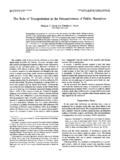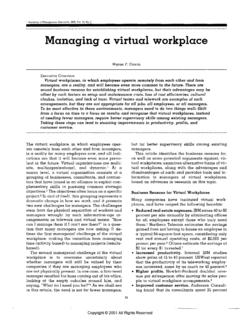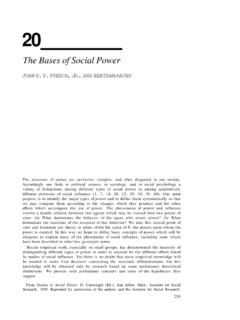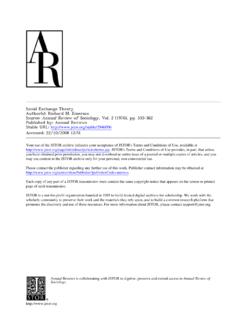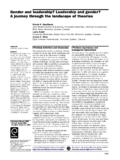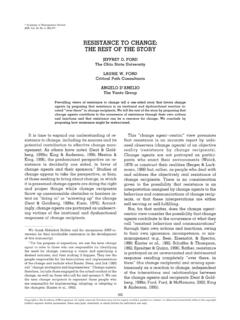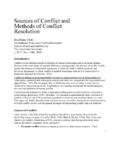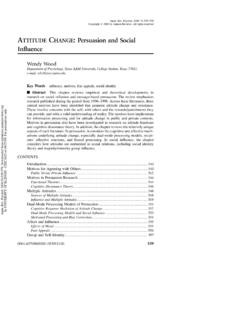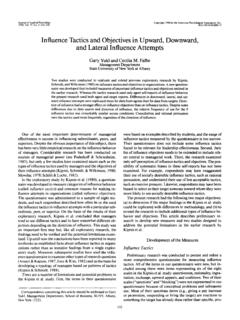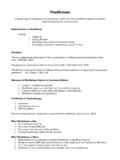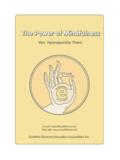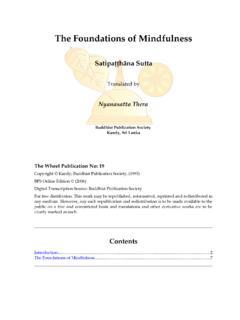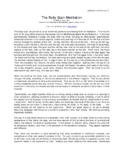Transcription of Mindfulness and Interpersonal Communication
1 Journal of Social Issues, Vol. 56, No. 1, 2000, pp. 105 127. Mindfulness and Interpersonal Communication Judee K. Burgoon*. University of Arizona Charles R. Berger University of California at Davis Vincent R. Waldron Arizona State University West Many social problems can be traced to Interpersonal Communication difficulties, just as many proposed interventions to solve social ills also depend on effective Interpersonal Communication . This article examines three potential relationships between states of mind and social interaction followed by illustrations from research related to five exemplar social issues developing effective programs for solving workplace Communication problems, training the public to detect scams and hoaxes, reducing stereotyping and cross-cultural misunderstanding, managing Interpersonal conflict, and constructing effective public health cam- paigns.
2 We conclude by considering the likely inhibiting and facilitating effects of Mindfulness -mindlessness on socially relevant transactions. That seemingly mindless Communication occurs frequently comes as no surprise to even the casual observer of human interaction. Illustrative of a remark- able capacity for humans to dissociate thought and talk are these nuggets mined from the world of work: We know that Communication is a problem, but the company is not going to discuss it with the employees. (from a major provider of communications services). As of tomorrow, employees will only be able to access the building using individual secu- rity cards. Pictures will be taken next Wednesday and employees will receive their cards in two weeks.
3 (from a computer software corporation). *Correspondence concerning this article should be addressed to Judee K. Burgoon, Department of Communication , University of Arizona, Tucson, AZ 85721 [e-mail: 105. 2000 The Society for the Psychological Study of Social Issues 106 Burgoon, Berger, and Waldron What I need is a list of specific unknown problems we will encounter. (from a shipping company). One can easily imagine the adverse repercussions of such Communication , especially if less trivial examples, such as Communication between air traffic controllers and pilots, were substituted for these humorous ones. Although much has been written about the consequences of mindless Communication (see, , J.)]
4 K. Burgoon & Langer, 1995; Hample, 1992; Langer, 1992), it may prove more enlightening when considering social problems to focus on the mindful end of the mindless-mindful continuum. We will therefore address how greater Mindfulness can be elicited in and strategically managed through Interpersonal Communication , with an eye toward how such behavior can ameliorate various social ills and accrue other social benefits. Preliminary to that analysis, we first clarify our conceptual- ization of Mindfulness within the Interpersonal interaction context. We then exam- ine the role of Mindfulness with respect to social interactions organized around such practical Communication goals as detecting deception in work and public con- texts, avoiding stereotyping and other biased social information, reducing conflict and intercultural misunderstandings, and creating effective public health cam- paigns for AIDS prevention.
5 Mindfulness in the Interpersonal Communication Domain As individuals engage in social interaction, verbal and nonverbal communica- tion channels afford them a wealth of potential information. The content, structure, and sequencing of verbal messages, as well as the paralinguistic cues, gestures, facial expressions, body movements and cues provided by the physical environ- ment that accompany verbal messages, all afford considerable grist for social actors' comprehension and interpretative mills. It is within this highly complex Interpersonal Communication matrix, one in which streams of social action and individual cognitive processes intertwine and run off rapidly, that we examine Mindfulness -mindlessness.
6 Although Mindfulness is often equated with actors producing, comprehend- ing, and interpreting verbal and nonverbal messages in a deliberate, rational fash- ion that reflects not only forethought but also ongoing monitoring of the discursive stream, it would be a misconstrual of the concept to equate Mindfulness with con- scious, planful, or strategic Communication and mindlessness with thoughtless or habituated activity. Langer (1989) makes clear that Mindfulness refers to active and fluid information processing, sensitivity to context and multiple perspectives, and ability to draw novel distinctions. This state of mind may be operative even as habituated Communication subroutines are run off automatically.
7 In fact, the very capacity to engage in the kinds of semiautomatic conduct that characterizes many routine aspects of Interpersonal interaction may free the cognitive resources necessary to make the dynamic, contingent, and novel mental discriminations Langer envisions. Mindfulness and Interpersonal Communication 107. What, then, is the relationship between people's state of mind and their social interaction? Three different relationships are possible, which we illustrate with sample social issues. First, verbal and nonverbal Communication patterns may signal how mindful message senders or recipients are at any given point in time. Message form or content may indicate the presence or absence of flexible, condi- tional, cognitively complex, and creative thought processes on the part of message producer or message recipient.
8 In the realm of physician-patient interaction, this might be manifested in the case of the physician who prescribed suppositories for a patient who proceeded to take them orally. This exchange might be taken as evidence of the physician's mindlessness, because she failed to anticipate the various ways patients use medications and thus neglected to instruct the patient in their proper use, or it could be viewed as the patient's mindlessness, because she failed to consider the range of alternative ways in which medications might be taken, or both. In general, following routine scripts for prescribing and taking medicines easily leads to inadequate specificity and mindless responding.
9 Asking less educated patients to paraphrase their understanding of a course of treatment could constitute an opposite case of Communication -as-sign-of- Mindfulness . Second, Communication itself may be the object of thought processes both on the encoding (message creation) and decoding (message interpretation) side of an Interpersonal exchange. The demand-withdraw pattern in marital interaction, in which spouses (usually wives) fall into habitual ways of expressing disgruntlement with their partner's detachment and their partners (usually husbands) respond with chronic stonewalling and withdrawal, creates persistent and pernicious cycles that can be characterized as mindless because interactants fail to entertain alternative ways of resolving their grievances.
10 They stand in contrast to mindful approaches in which couples, attuned to how dysfunctional such Communication practices are, resort to new and more constructive ways of dealing with dissatisfaction. Other repetitive messages, such as media campaigns that endlessly reiterate the same stock appeals to promote sun awareness and cancer prevention, without entertain- ing alternative ways to deliver their message, similarly qualify as mindless encod- ing, in contrast to advertisements that incorporate novel formats and arguments. On the decoding side, automatic and instantaneous reactions as in the case of political conservatives automatically interpreting the phrase affirmative action.
